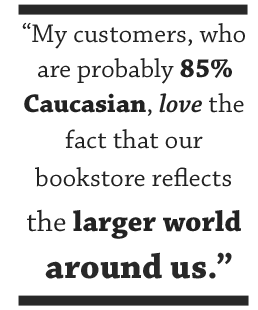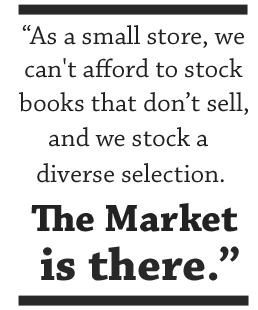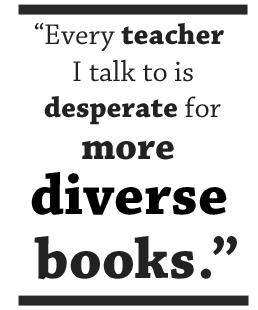We Are the Problem, We Are the Solution
 Elizabeth Bluemle is the co-owner of the Flying Pig Bookstore in Shelburne, VT.
Elizabeth Bluemle is the co-owner of the Flying Pig Bookstore in Shelburne, VT.
As an independent bookseller, former school librarian, and lifelong avid reader, I crave the day when publishing lists are as ![]() diverse and rich as the playgrounds of our nation, and the conversation about representations of diversity in children’s literature is as unnecessary as the question of whether or not women should vote. Until that happens, there is no discussion more vital in the children’s book world than how to bring our industry at every level in line with America’s diversity.
diverse and rich as the playgrounds of our nation, and the conversation about representations of diversity in children’s literature is as unnecessary as the question of whether or not women should vote. Until that happens, there is no discussion more vital in the children’s book world than how to bring our industry at every level in line with America’s diversity.
I’ve written about this subject often over the last several years, for Publishers Weekly’s Shelftalker blog and the CCBC Diversity Committee blog, and while it seems we are, as a whole, talking a lot more about these issues within the field, and while there have been some increase in the number of mainstream children’s books featuring kids of color, we are still so far behind.
The problem is systemic and deeply rooted and requires change at every level, from the publishing houses to artists and writers to booksellers, educators, and ![[A]dults make all kinds of erroneous assumptions about what will and won’t interest children.](http://www.leeandlow.com/images/bookseller-caption1.gif) consumers. We booksellers have more opportunity to effect change than we might imagine. People entrust us with book recommendations from individual purchases to helping plan school curricula on a grand scale, and this affords us the most amazing opportunity to be aware of what we are recommending. One of the challenges inherent in selling children’s books is that we usually have to go through one or two levels of gatekeepers to reach a book’s intended audience, the child reader. We are selling to teachers and librarians, and to parents and other adult family and friends.
consumers. We booksellers have more opportunity to effect change than we might imagine. People entrust us with book recommendations from individual purchases to helping plan school curricula on a grand scale, and this affords us the most amazing opportunity to be aware of what we are recommending. One of the challenges inherent in selling children’s books is that we usually have to go through one or two levels of gatekeepers to reach a book’s intended audience, the child reader. We are selling to teachers and librarians, and to parents and other adult family and friends.
In my seventeen years as a bookseller and three years as a school librarian before that, if there’s one thing I have noticed, it’s that we adults make all kinds of erroneous assumptions about what will and won’t interest children. Time and time again, at the bookstore and at children’s book festivals, I have observed white children picking up books with kids of color on the cover, and heard adults express surprise at the choice. “Are you sure you want that one?” they’ll ask. Or, “Wouldn’t you like this book instead?” It’s not the kids who are the problem. Kids really, really, really only care about a great story. In twenty years of connecting children with books they love, I have only seen one child—ONE!—balk at a book cover because the main character was a different race from her own. It’s the adults who underestimate a child’s ability or desire to see beyond race.
The good news is that those same adults will usually respond well to bookseller enthusiasm for titles and allow their own reservations (which they aren’t even consciously aware of) to be shifted. At the end of this article, I’ll share some of our tried-and-true methods for getting beyond our own unconscious biases and those of our customers.
 Independent booksellers have complete control over what we carry and how books are displayed. No corporate office is dictating titles, quantities, or placement, or telling us what to face out on our display furniture. At the Flying Pig, we have the great joy to display the books that our staff truly love. This means enormous freedom and responsibility to look at our choices, and to make sure that what we stand behind represents a variety of viewpoints.
Independent booksellers have complete control over what we carry and how books are displayed. No corporate office is dictating titles, quantities, or placement, or telling us what to face out on our display furniture. At the Flying Pig, we have the great joy to display the books that our staff truly love. This means enormous freedom and responsibility to look at our choices, and to make sure that what we stand behind represents a variety of viewpoints.
After spending most of my life in big cities, from Phoenix to Los Angeles to San Francisco to New York City, I ended up in Vermont, one of the country’s least diverse states, and opened a bookstore here. When selecting my inventory, I have always stocked my store like a big-city store, with as many diverse titles as possible. We don’t separate multicultural titles, as some stores do. While that approach has a single advantage, that of browsing efficiency for customers expressing a specific interest, it is otherwise problematic for me on many levels and I have never found it necessary or desirable to follow it. My customers, who are probably 85% Caucasian, love the fact that our bookstore reflects the larger world around us. Most book-loving parents want their children to encounter both the uniqueness and universality of characters. It’s how we start to build a more tolerant and rich world.
So what can we booksellers do to help?
- Examine our own assumptions and unspoken biases. Remember that people don’t only want to read about characters who look like them. That’s a superficial criterion, and one that becomes increasingly ridiculous the more you think about it. Are we remembering to recommend books featuring main characters of color to white customers? Are we avoiding recommending these books to families of color because we don’t want to appear racist, or recommending only these books because we are assuming a narrow range or interest? In my experience, families of all races welcome books featuring a wide variety of faces, and they appreciate booksellers who can offer diverse reading. Customers so often take their cue from our knowledge, expertise, and delight in books.
- Be aware that color-blindness isn’t the goal, but color-inclusiveness is. Instead of trying to erase race, we are celebrating the broad scope of difference and sameness among all people.
- Booktalk a range of books to your customers, remembering that it’s always story that hooks them in. Lead with the hook. If you sense that a customer might be hesitant, don’t show a book cover until they’re already interested in the story. Booktalk diverse books the way you would any great book, by getting kids excited about the characters, the adventure, the situations in the story. Here are a few quickie examples of booktalks for diverse titles that always get kids interested: For Mr. Chickee’s Funny Money: “This kid is given a quadrillion-dollar bill and Secret Agents are trying to get it back.” For Bobby vs. the Girls (Accidentally): “Bobby used to have a girl best friend, but now they’re in fourth grade, and things are changing. Everything starts going wrong; he can’t even hug a tree without getting stuck to it.” For Alvin Ho: Allergic to Girls, School, and Other Scary Things: “Alvin, descended from warrior farmers, is afraid of everything. Now he’s in a public school and exposed to a neighborhood full of potential disasters.” Hook ‘em with the good stuff; they won’t care two hoots about race. For Summer of the Mariposas, “When five sisters discover a dead body in the river, they set out on an adventurous journey, full of mythical characters and magic, to take the drowned man to Mexico.”
- If race isn’t an issue in the book, don’t make it an issue in your booktalk. Treat the book like any other. No disclaimers. Your enthusiasm will overcome reluctance. If they say, “He won’t be interested in that,” you can
 still navigate those waters. Possible follow-ups: “Oh, but kids love this book!” (Followed by another scintillating hook.) OR: “This is a huge favorite at the local school.” OR: “It’s gotten starred reviews / won awards.” Of course, these statements must actually be true.
still navigate those waters. Possible follow-ups: “Oh, but kids love this book!” (Followed by another scintillating hook.) OR: “This is a huge favorite at the local school.” OR: “It’s gotten starred reviews / won awards.” Of course, these statements must actually be true. - Become familiar with a wider array of books, especially from small presses specializing in multicultural books. Let your sales reps from all houses know you’re interested in broadening your selection. This can be a very fruitful conversation.
- Let your customers know that you carry a strong selection of multicultural books. Even in homogenous neighborhoods, you’ll often be surprised by how many people appreciate and buy the books you’ve made available to them.
- If you are looking for resources, there are many great blogs that review multicultural books. I also keep a diversity database on LibraryThing, which lists almost 900 children’s books featuring main characters of color where race is NOT the driving issue of the story. It’s been good to see that there are many titles published in 2013 that I’ll be able to add to this database. We are creeping toward a better field.
- Books are books. The best ones cross racial and cultural lines; they aren’t narrowly black-interest books, white-interest books, Asian-interest books, but people-interest books. Believe in your own passion for stories and literature and nonfiction, and hand the best books to kids of all colors, about people of all colors. Remind customers of books like Corduroy and The Snowy Day, beloved by generations of children because of their universal appeal. It’s surprising how effective mentioning specific books can be in making your point with parents.
- Finally, let publishers know BY YOUR SALES that you welcome and want and need diverse children’s books. It truly is the most important thing we can do for all of the children we serve. Zetta Elliott, a writer and professor in New York, expresses the need beautifully in her post, Something like an Open letter to the children’s publishing industry. She writes:
People of color make up a third of the population, and before too long, we’ll reach 50%. In 2050 will we still be petitioning the children’s publishing industry to be more responsive to our needs–OUR urgencies? . . . What I am trying to say to children’s publishers is that the lack of books for children in our communities IS A MATTER OF LIFE AND DEATH. I am not asking you to level the playing field as a ‘favor’ to people of color. I am asking you to work with us in our efforts to transform children’s lives. Isn’t that why you chose this field in the first place? . . . In the 21st century, when we have managed to elect our first African American president, how is it possible that the children’s publishing industry is still 98% white? Is it any wonder, then, that the books being produced for children are also disproportionately white?
 This article isn’t a pie-in-the-sky pipe dream about how the bookselling world should be. The readers are there. As a small store, we can’t afford to stock books that don’t sell, and we stock a diverse selection. The market is there. Every teacher I talk to is desperate for more diverse books. Kids are eager to read great books and diverse faces on books reflect themselves and their friends. When publishing lists fatten up with rich, exciting, funny, mysterious, adventurous, fantastical choices with main characters who happen not to be white—choices beyond history titles and stories of struggle—and big marketing dollars go to those books, sales will rise. It’s time for those of us who write, publish, recommend, and sell books to realize that diversity is not alien or new or unappealing to American kids; we’re the ones who need to catch up.
This article isn’t a pie-in-the-sky pipe dream about how the bookselling world should be. The readers are there. As a small store, we can’t afford to stock books that don’t sell, and we stock a diverse selection. The market is there. Every teacher I talk to is desperate for more diverse books. Kids are eager to read great books and diverse faces on books reflect themselves and their friends. When publishing lists fatten up with rich, exciting, funny, mysterious, adventurous, fantastical choices with main characters who happen not to be white—choices beyond history titles and stories of struggle—and big marketing dollars go to those books, sales will rise. It’s time for those of us who write, publish, recommend, and sell books to realize that diversity is not alien or new or unappealing to American kids; we’re the ones who need to catch up.


Some of my Facebook friends recommended the following bookstores as ones that support, stock, and sell diverse books. If you know of others leave them in the comments section:
http://www.roomofonesown.com/
https://www.facebook.com/TheLittleScholar
https://www.facebook.com/MysteriousGalaxy
https://www.facebook.com/MysteriousGalaxyRB
BookPeople, Austin TX
Bear Pond Books, Montpelier, VT
http://www.bluemanateebooks.com/
http://www.quailridgebooks.com/
Market Street Bookshop Mashpee, MA
The Blue Marble, Ft. Thomas, Kentucky
Bluestockings in the lower east side NYC
http://www.womenandchildrenfirst.com/wcf-history-and-purpose
Fundamentals Parent Teacher Bookstore in Delaware, Ohio, Tami Furlong, owner
Book House/Little Book House in Albany, NY
The Hickory Stick in Washington Depot, CT
Terrific post, Elizabeth! It’s time to stop buying into old paradigms of color-blindness and begin looking at what inclusion really means.
Hooray, Elizabeth! Fantastic post with concrete suggestions. Thank you!
Here’s my favorite local kids’ book store that sells diverse books:
http://www.eightcousins.com/
They’re located in Falmouth, MA.
Just this week they hosted an event with Sara Farizan, author of IF YOU COULD BE MINE.
Wow! Great insights in the article. As a parent, I wish there are more children’s books in the market with multicultural characters. I think it is so important for kids to learn about cultures and diversity in today’s world. Thanks for the great post!
It is wonderful to make books that are as colorful, diverse and unique as our world.
As an adopted person, I looked different and felt like an outsider in this new family. It would have been wonderful to find books that reflected this reality.
Children can be supported in being unique, but still understand that they belong in their family, community, and our big colorful world.
Author/Illustrator of GreenBean: True Blue Family.
Yes! I completely agree and couldn’t have said it better myself! (Although I try to get this message across when I speak with teachers and parents at conferences and book events.) Thank you!
Kids Ink in Indianapolis allowed us to offer an exclusively diverse book fair in our community. They did, however, have a difficult time obtaining the diverse books from their distributors.
The main avenue through which teachers and children get books is via Scholastic Book Fairs and Book Clubs. The offerings include virtually NO diversity. I would love to see Lee and Low get in the book fair game and change the “face” of the literature children and teachers are offered.
LOVE THIS!!! And was just in your bookstore this summer, buying lots of books!!!
Reblogged this on Rambling Justice.
This is a wonderful article. As an emerging YA author with multicultural characters, I have been struggling to find book blogs that will review multicultural books. Do you happen to have any suggestions?